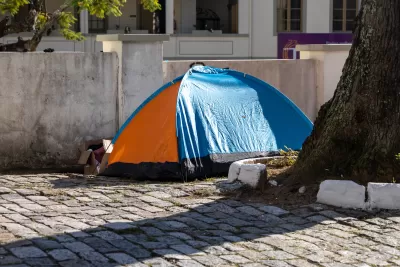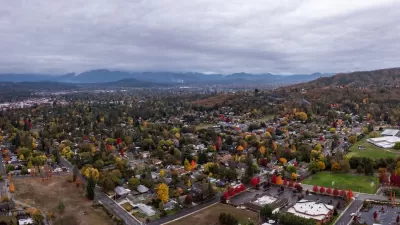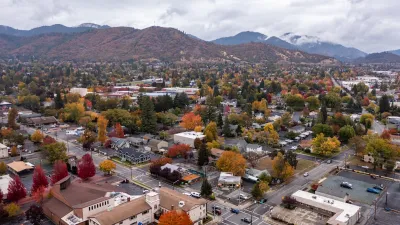In Grants Pass v. Johnson, the Supreme Court upheld an Oregon city’s ban on camping in public places, paving the way for similar bans in cities across the country but doing nothing to solve the cause of homelessness.

Last week, in a 6-3 decision along ideological lines, the U.S. Supreme Court ruled that local governments’ camping bans do not violate the Cruel and Unusual Punishments Clause of the Eighth Amendment to the federal Constitution. The ruling clears the way for cities witnessing rapidly increasing homeless populations to enforce rules prohibiting unhoused persons from sleeping outdoors. Although the decision affords local officials one means to respond to the growing homelessness crisis, it leaves cities and housing advocates to address the root causes of or solutions to homelessness.
Burgeoning crisis
Homelessness has become a major problem in U.S. cities. A December 2023 report from the U.S. Department of Housing and Urban Development reported that, on any given night in 2023, approximately 653,100 people experienced homelessness. That figure represented a 12 percent increase from 2022. Of those experiencing homelessness, approximately 40 percent were unsheltered, meaning they slept outdoors, on streets, in parks, or other areas unfit for habitation. Black and Native American persons experience homelessness at greater rates than the overall population. A large majority of persons experiencing homelessness have a disability and many face substance-abuse challenges.
Of the U.S. population experiencing homelessness, over a quarter were in California, while other Western states such as Oregon, Washington, and Nevada also had outsized unhoused populations.
For people experiencing homelessness, housing options are limited. Amid a national housing crisis, low-cost apartments or homes are hard to find. Government agencies and nonprofit organizations may offer emergency shelter. Some local governments and other organizations have expanded supportive housing options. Nevertheless, some local governments assert that people experiencing homelessness decline offers of shelter, for a variety of reasons.
States and cities have taken many approaches to address this crisis. Some have expanded mental health treatment programs and added housing and shelter options. Others have employed resource officers to work with unhoused individuals and direct them to needed services. In addition to these approaches, many local governments ban camping in outdoor public spaces. Under these bans, cities clear encampments and order campers to move on from outdoor sleeping locations. Bans also enable criminal punishment for violators. Advocates say camping bans like these criminalize homelessness and poverty.
Seeking legal relief
In 2019, the federal Ninth Circuit Court of Appeals, which covers several Western states, ruled that Boise, Idaho’s camping ban was unconstitutional. It found the ban constituted cruel and unusual punishment, barred by the Eighth Amendment, because people experiencing homelessness had no other shelter. In the case, Martin v. City of Boise, the court concluded Boise lacked sufficient shelter beds for its unhoused population, despite the city’s assertion that many of its shelter beds went unused.
That decision touched off multiple lawsuits by unhoused people against Western localities, including San Francisco, rendering many cities’ camping bans unenforceable. Many cities asserted that their inability to enforce these bans has increased the unhoused population.
The case before the U.S. Supreme Court this year, Grants Pass v. Johnson, considered a ban on camping in streets and public parks. Two people experiencing vehicular homelessness filed a class action lawsuit on behalf of unhoused people in Grants Pass, Oregon. The ban was enjoined under Martin, as the district court found the city lacked sufficient “practically available” shelter beds. After the Ninth Circuit affirmed, the city petitioned for Supreme Court review. Many cities and states supported the petition as amici. The Court granted it.
In ruling for the city and writing for the majority, Justice Neil Gorsuch observed that the Cruel and Unusual Punishments Clause was included in the Eighth Amendment to avoid “barbaric punishments like ‘disemboweling, quartering, public dissection, and burning alive.’” Per Gorsuch, the Clause addresses what happens after a person is convicted of a crime, not whether a particular act could be criminalized in the first place. The majority further reasoned that the city’s law was not cruel, as it only imposed a fine for a first-time offender and allowed for entry of an order barring public camping before a person would receive criminal punishment.
Justice Thomas concurred with the decision, writing separately to note that he does not perceive fines or anti-camping orders as punishment. Justice Sotomayor, joined by Justices Jackson and Kagan, dissented, arguing that sleep is a biological necessity and that criminalizing it for people who cannot afford adequate shelter amounts to cruel and unusual punishment.
Moving forward
Although Grants Pass now allows cities to enact and enforce camping bans, it is clear that bans alone will not solve the homelessness crisis. Outside of the Ninth Circuit, cities have continued to clear encampments and penalize violators, yet encampments continue to crop up and people cycle between unsheltered homelessness and the criminal justice system. Addressing the homelessness crisis is far more complex than simply enacting a camping ban, although such bans may encourage some unhoused people to seek shelter beds.
For cities, states, and the federal government, other options are available. Many people point to Houston’s Housing First program as a model. That program focuses on placing unhoused people into housing with supportive services. It was credited with dramatically reducing the city’s unhoused population between 2011 and 2020. Despite its success in reducing homelessness, the program’s critics argue that it imposes involuntary treatment on people who may not want it.
Other options for addressing the crisis include expanding permanent supportive housing, which combines affordable housing with support services. Governments often provide this housing alongside nonprofit partners. Additionally, some people argue that the federal government should expand housing choice vouchers for people experiencing homelessness. Other alternatives to prevent homelessness include grants and other aid for people at risk of eviction and expanding legal services for tenants in housing court. Programs that assist lower-income people with job training, child care, healthcare, and mental health are also important. Since many people experiencing homelessness have disabilities, providing services for people with disabilities is also critical. In the wake of Grants Pass, advocates and government agencies should focus their efforts in these areas.
More broadly, solving homelessness also requires cities to allow more housing in their communities. Research shows that high housing costs produce more homelessness. High housing costs result in part from undersupply because of restrictions on new housing, particularly multi-family buildings. States and cities can continue to ease the housing crisis by encouraging new housing production. Advocates for unhoused people are rightly engaging closely in ongoing state and local debates around zoning reform.
Brian J. Connolly is an Assistant Professor of Business Law at the Stephen M. Ross School of Business at the University of Michigan. He is a planner and lawyer whose current research focuses on real estate, land use, zoning, and housing issues.

Trump Administration Could Effectively End Housing Voucher Program
Federal officials are eyeing major cuts to the Section 8 program that helps millions of low-income households pay rent.

Planetizen Federal Action Tracker
A weekly monitor of how Trump’s orders and actions are impacting planners and planning in America.

Ken Jennings Launches Transit Web Series
The Jeopardy champ wants you to ride public transit.

‘Smart Surfaces’ Policy Guide Offers Advice for Building and Maintaining Urban Tree Canopies
Healthy, robust tree canopies can reduce the impacts of extreme heat and improve air quality.

New Jersey Lawsuit Targets Rent-Setting Algorithms
The state of New Jersey is taking legal action against landlords and companies that engage in what the state’s Attorney General alleges is illegal rent fixing.

Washington Legislature Passes Rent Increase Cap
A bill that caps rent increases at 7 percent plus inflation is headed to the governor’s desk.
Urban Design for Planners 1: Software Tools
This six-course series explores essential urban design concepts using open source software and equips planners with the tools they need to participate fully in the urban design process.
Planning for Universal Design
Learn the tools for implementing Universal Design in planning regulations.
Heyer Gruel & Associates PA
Ada County Highway District
Institute for Housing and Urban Development Studies (IHS)
City of Grandview
Harvard GSD Executive Education
Toledo-Lucas County Plan Commissions
Salt Lake City
NYU Wagner Graduate School of Public Service





























